-

新人教版高中英语选修2Unit 1 Science and Scientists-Reading and thinking教学设计
Step 5: After learning the text, discuss with your peers about the following questions:1.John Snow believed Idea 2 was right. How did he finally prove it?2. Do you think John Snow would have solved this problem without the map?3. Cholera is a 19th century disease. What disease do you think is similar to cholera today?SARS and Covid-19 because they are both deadly and fatally infectious, have an unknown cause and need serious public health care to solve them urgently.keys:1. John Snow finally proved his idea because he found an outbreak that was clearly related to cholera, collected information and was able to tie cases outside the area to the polluted water.2. No. The map helped John Snow organize his ideas. He was able to identify those households that had had many deaths and check their water-drinking habits. He identified those houses that had had no deaths and surveyed their drinking habits. The evidence clearly pointed to the polluted water being the cause.3. SARS and Covid-19 because they are both deadly and fatally infectious, have an unknown cause and need serious public health care to solve them urgently.Step 6: Consolidate what you have learned by filling in the blanks:John Snow was a well-known _1___ in London in the _2__ century. He wanted to find the _3_____ of cholera in order to help people ___4_____ it. In 1854 when a cholera __5__ London, he began to gather information. He ___6__ on a map ___7___ all the dead people had lived and he found that many people who had ___8____ (drink) the dirty water from the __9____ died. So he decided that the polluted water ___10____ cholera. He suggested that the ___11__ of all water supplies should be _12______ and new methods of dealing with ____13___ water be found. Finally, “King Cholera” was __14_____.Keys: 1. doctor 2. 19th 3.cause 4.infected with 5.hit 6.marked 7.where 8.drunk 9.pump 10.carried 11.source 12.examined 13.polluted 14.defeatedHomework: Retell the text after class and preview its language points

新人教版高中英语选修2Unit 1 Science and Scientists-Using langauge教学设计
This happens because the dish soap molecules have a strong negative charge, and the milk molecules have a strong positive charge. Like magnets, these molecules are attracted to each other, and so they appear to move around on the plate, taking the food coloring with them, making it look like the colors are quickly moving to escape from the soap.Listening text:? Judy: Oh, I'm so sorry that you were ill and couldn't come with us on our field trip. How are you feeling now? Better?? Bill: Much better, thanks. But how was it?? Judy: Wonderful! I especially liked an area of the museum called Light Games.it was really cool. They had a hall of mirrors where I could see myself reflected thousands of times!? Bill: A hall of mirrors can be a lot of fun. What else did they have?? Judy: Well, they had an experiment where we looked at a blue screen for a while, and then suddenly we could see tiny bright lights moving around on it. You'll never guess what those bright lights were!? Bill: Come on, tell me!? Judy: They were our own blood cells. For some reason, our eyes play tricks on us when we look at a blue screen, and we can see our own blood cells moving around like little lights! But there was another thing I liked better. I stood in front of a white light, and it cast different shadows of me in every color of the rainbow!? Bill: Oh, I wish I had been there. Tell me more!? Judy: Well, they had another area for sound. They had a giant piano keyboard that you could use your feet to play. But then, instead of playing the sounds of a piano, it played the voices of classical singers! Then they had a giant dish, and when you spoke into it, it reflected the sound back and made it louder. You could use it to speak in a whisper to someone 17 meters away.? Bill: It all sounds so cool. I wish I could have gone with you? Judy: I know, but we can go together this weekend. I'd love to go there again!? Bill: That sounds like a great idea!
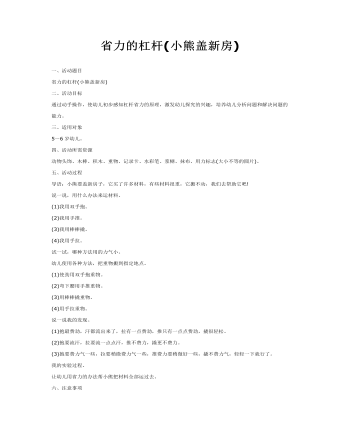
科学教案:小熊盖新房(省力的杠杆)
二、活动目标通过动手操作,使幼儿初步感知杠杆省力的原理,激发幼儿探究的兴趣,培养幼儿分析问题和解决问题的能力。三、适用对象5~6岁幼儿。四、活动所需资源动物头饰、木棒、积木、重物、记录卡、水彩笔、浆糊、抹布、用力标志(大小不等的圆片)。五、活动过程导语:小熊要盖新房子,它买了许多材料,有些材料很重,它搬不动,我们去帮助它吧!说一说,用什么办法来运材料。
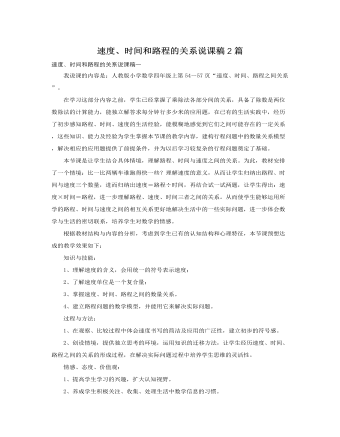
人教版新课标小学数学四年级上册速度、时间和路程的关系说课稿2篇
二、教材分析本节课是让学生结合具体情境,理解路程、时间与速度之间的关系。为此,教材安排了一个情境:比一比两辆车谁跑得快一些?从而让学生归纳出路程、时间与速度三个数量,进而归纳出速度=路程÷时间,再结合试一试两题,让学生得出:路程=速度×时间,时间=路程÷速度,进一步理解路程、速度、时间三者之间的关系。因此,理解路程、时间与速度之间的关系是本节课的重点,难点是速度的单位。学习了这节课,学生可以解决生活中的一些实际问题,并且可以合理地安排时间,提高效率。三、学情分析学生对于路程、时间与速度的关系一定有所了解,但他们虽然知道三者之间的数量关系式,却并不十分了解为什么有这样的关系。因此,在课上应遵循“问题情境---建立模式---解释应用”的基本叙述模式,为学生自主参与、探究和交流提供时间和空间。四、教学目标
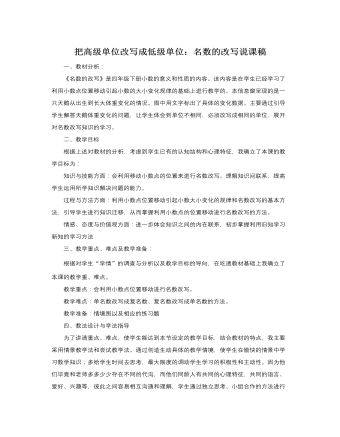
人教版新课标小学数学四年级下册把高级单位改写成低级单位:名数的改写说课稿
一、教材分析:《名数的改写》是四年级下册小数的意义和性质的内容。该内容是在学生已经学习了利用小数点位置移动引起小数的大小变化规律的基础上进行教学的。本信息窗呈现的是一只天鹅从出生到长大体重变化的情况。图中用文字标出了具体的变化数据。主要通过引导学生解答天鹅体重变化的问题,让学生体会到单位不相同,必须改写成相同的单位,展开对名数改写知识的学习。二、教学目标根据上述对教材的分析,考虑到学生已有的认知结构和心理特征,我确立了本课的教学目标为:知识与技能方面:会利用移动小数点的位置来进行名数改写。理解知识间联系,提高学生运用所学知识解决问题的能力。过程与方法方面:利用小数点位置移动引起小数大小变化的规律和名数改写的基本方法,引导学生进行知识迁移,从而掌握利用小数点的位置移动进行名数改写的方法。

人教版新课标小学数学四年级上册因数中间或末尾有0的乘法说课稿2篇
然后我让自主尝试探索末尾有0有乘法,然后让学生自己上台来给大家展示各自的算法,并讨论比较那种算法更简便,从而总结出末尾有0的乘法列竖式的简便方法。为了解决这节课的重点和难点,我在这个环节里又有针对性的设计了两个练习,一个是0和非0的对位,还有一个是积末尾补0。在教学因数中间有0的乘法,因为学生有了前面的基础,所以我直接让学生在两个问题中选择一个解决。重点强调了因数中间0不能漏乘。在练习方面,我设计了看谁的眼睛亮,通过找错误,学生练习时,老师观察到有共性的的错误,通过视频展示台,让学生来寻找错误,再次突破本课的重点。一题是360×25因数末数一共有一个0,而积的末尾应该有三个0。让学生进行讨论,再一次让学生体会了积末尾0个数确定的方法。在巩固和拓展联系环节,设计了闯关游戏,先是基本的计算练习,接着是因数末尾0个数的判断和解决问题的联系,通过练习,巩固竖式的简便写法,提高学生的计算能力。
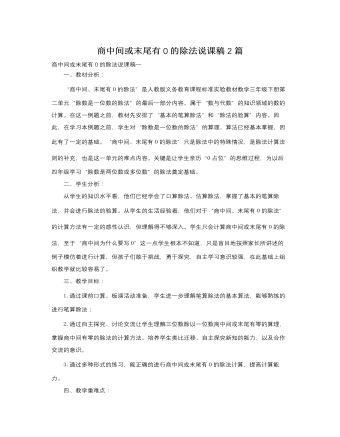
人教版新课标小学数学三年级下册商中间或末尾有0的除法说课稿2篇
教法、学法分析我通过阅读教材、教参和新课标,分析学生学习状况,认为对这一教学内容理解起来比较容易。所以,在教学时我准备采取以下策略:1、放手让学生自主解决问题,尝试计算例7的1、2题。再通过学生口述计算过程,教师设问、强调重点使学生掌握本节课知识。2、通过学生反复叙述算理,培养学生口头表达能力,并使他们自主探索“被除数中间或末尾没有0,商中间或末尾有0”这一知识形成的过程。教学目标1、在熟练掌握一位数笔算除法法则的基础上,会正确计算商中间或末尾有0的除法的另一种情况。2、能熟练地进行商中间有零和末尾有零的除法,形成一定的笔算技能。3、能结合具体情境估算三位数除以一位数的商,增强估算的意识和能力。
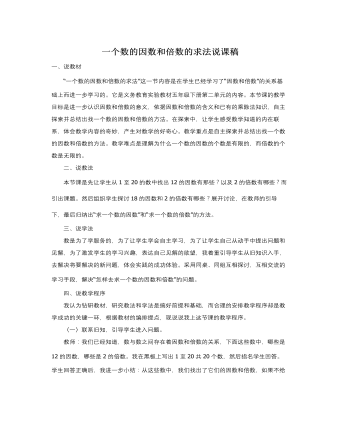
人教版新课标小学数学五年级下册一个数的因数和倍数的求法说课稿
在游戏中巩固知识,并体会区间套的数学思想,有利于培养学生的数感。做游戏时间不能过长,我只安排在4分钟内完成,让学生在学中乐和乐中学的兴趣。〈四〉全课总结今天这节课你们学了什么知识?有哪些收获?(让学生进行互说来结束本节课)五、说板书板书是体现课文内容脉落的载体。通过板书学生可以一目了然地弄请本节课你所授的内容知识的过程,让人永久深记,印象深刻。我的板书设计如下:一个数的因数和倍数的求法例1、18的因数有哪几个?18的因数有:1、2、3、6、9、18一个数的因数的个数是有限的,其中最小是1,最大的因数是它本身。方法:①哪两个自然数积等于18,则哪两个自然数就是这个数的因数。②哪个数能整除18,则哪个数就是这个数的因数。例2、2的倍数有哪些?一个数的倍数的个数是无限的,其中最小的倍数是它本身,没有最大的倍数。方法:用2与所有的自然数相乘,积就是它的倍数。
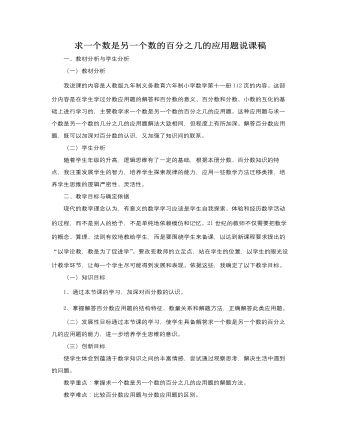
人教版新课标小学数学六年级上册求一个数是另一个数的百分之几的应用题说课稿
第二阶段从具体步骤上的感知到解题方法的抽象概括,让学生结合板书的解题步骤,说出百分数应用题的解题方法及与分数应用题的区别与联系,通过这一阶段明确了百分数应用题的解答方法。有水到渠成之效。(三)巩固练习,促进知识内化教师出示书中的练习二十九的第1题及补充题,练习后说说理由。这一环节可以看出学生是否掌握了解答百分数应用题的方法,是否会用百分数的意义去检验结果的合理性。(四)通过出示思考题,发展提高教师在学生注意力高度集中、思维活跃的情况下引出思考题:不改变补充题的两个已知条件,你还可以提出哪些问题呢?是学习例1后知识的运用与延伸,也为今后学习求一个数比另一个数多百分之几的应用题做了铺垫。五、教学效果(一)进入六年级,进一步提高学生解答应用题的能力,并能够运用所学知识解答生活中的实际问题。
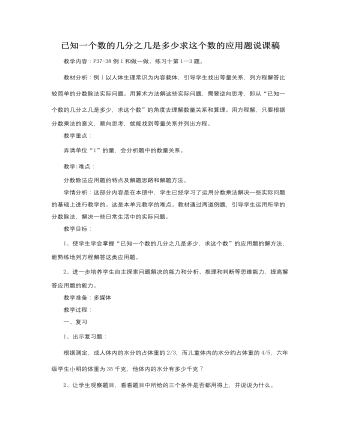
人教版新课标小学数学六年级上册已知一个数的几分之几是多少求这个数的应用题说课稿
(1)启发学生找到分率句,确定单位“1”。(2)让学生选择一种自己喜爱的解法进行计算,独立解决第二个问题。(3)指名说说自己是怎样理解题意的,并与其他同学交流自己的解题思路。(出示线段图)爸爸的体重×7/15=小明的体重方程解算术解3、巩固练习:P38“做一做”(学生先独立审题完成,然后全班再一起分析题意、评讲)三、练习1、练习十第1—3题。(先分析数量关系式,然后确定单位“1”,最后再进行解答。第二题注意引导学生发现250ml的鲜牛奶是多余条件)2、练习十第6题(引导学生先求出单位“1”——爸爸妈妈两人的工资和1500+1000,再根据数量关系式进行计算)四、总结这节课我们学习了分数应用题中“已知一个数的几分之几是多少求这个数的应用题”,我们知道了,如果分率句中的单位“1”是未知的话,可以用方程或除法进行解答。

新人教版高中英语选修2Unit 2 Bridging Cultures-Discovering useful structures教学设计
The grammar of this unit is designed to review noun clauses. Sentences that use nouns in a sentence are called noun clauses. Nominal clauses can act as subject, object, predicate, appositive and other components in compound sentences. According to the above-mentioned different grammatical functions, nominal clauses are divided into subject clause, object clause, predicate clause and appositive clause. In this unit, we will review the three kinds of nominal clauses. Appositive clauses are not required to be mastered in the optional compulsory stage, so they are not involved.1. Guide the students to judge the compound sentences and determine the composition of the clauses in the sentence.2. Instruct students to try to learn grammar by generalizing grammar rules, controlling written practice, and semi-open oral output.3. Inspire the students to systematize the function and usage of noun clause1.Instruct students to try to learn grammar by generalizing grammar rules, controlling written practice, and semi-open oral output.2.Inspire the students to systematize the function and usage of noun clauseStep1: The teacher ask studetns to find out more nominal clauses from the reading passage and udnerline the nominal clauses.

新人教版高中英语选修2Unit 3 Food and Culture-Reading and thinking教学设计
The discourse explores the link between food and culture from a foreign’s perspective and it records some authentic Chinese food and illustrates the cultural meaning, gerography features and historic tradition that the food reflects. It is aimed to lead students to understand and think about the connection between food and culture. While teaching, the teacher should instruct students to find out the writing order and the writer’s experieces and feelings towards Chinese food and culture.1.Guide the students to read the text, sort out the information and dig out the topic.2.Understand the cultural connotation, regional characteristics and historical tradition of Chinese cuisine3.Understand and explore the relationship between food and people's personality4.Guide the students to use the cohesive words in the text5.Lead students to accurately grasp the real meaning of the information and improve the overall understanding ability by understanding the implied meaning behind the text.1. Enable the Ss to understand the structure and the writing style of the passage well.2. Lead the Ss to understand and think further about the connection between food and geography and local character traits.Step1: Prediction before reading. Before you read, look at the title, and the picture. What do you think this article is about?keys:It is about various culture and cuisine about a place or some countries.

新人教版高中英语选修2Unit 4 Journey Across a Vast Land教学设计
当孩子们由父母陪同时,他们才被允许进入这个运动场。3.过去分词(短语)作状语时的几种特殊情况(1)过去分词(短语)在句中作时间、条件、原因、让步状语时,相当于对应的时间、条件、原因及让步状语从句。Seen from the top of the mountain (=When it is seen from the top of the mountain), the whole town looks more beautiful.从山顶上看,整个城市看起来更美了。Given ten more minutes (=If we are given ten more minutes), we will finish the work perfectly.如果多给十分钟,我们会完美地完成这项工作。Greatly touched by his words (=Because she was greatly touched by his words), she was full of tears.由于被他的话深深地感动,她满眼泪花。Warned of the storm (=Though they were warned of the storm), the farmers were still working on the farm.尽管被警告了风暴的到来,但农民们仍在农场干活。(2)过去分词(短语)在句中作伴随、方式等状语时,可改为句子的并列谓语或改为并列分句。The teacher came into the room, followed by two students (=and was followed by two students).后面跟着两个学生,老师走进了房间。He spent the whole afternoon, accompanied by his mom(=and was accompanied by his mom).他由母亲陪着度过了一整个下午。

新人教版高中英语选修2Unit 3 Food and Culture-Discovering useful structures教学设计
The newspaper reported more than 100 people had been killed in the thunderstorm.报纸报道说有一百多人在暴风雨中丧生。(2)before、when、by the time、until、after、once等引导的时间状语从句的谓语是一般过去时,以及by、before后面接过去的时间时,主句动作发生在从句的动作或过去的时间之前且表示被动时,要用过去完成时的被动语态。By the time my brother was 10, he had been sent to Italy.我弟弟10岁前就已经被送到意大利了。Tons of rice had been produced by the end of last month. 到上月底已生产了好几吨大米。(3) It was the first/second/last ... time that ...句中that引导的定语从句中,主语与谓语构成被动关系时,要用过去完成时的被动语态。It was the first time that I had seen the night fact to face in one and a half years. 这是我一年半以来第一次亲眼目睹夜晚的景色。(4)在虚拟语气中,条件句表示与过去事实相反,且主语与谓语构成被动关系时,要用过去完成时的被动语态。If I had been instructed by him earlier, I would have finished the task.如果我早一点得到他的指示,我早就完成这项任务了。If I had hurried, I wouldn't have missed the train.如果我快点的话,我就不会误了火车。If you had been at the party, you would have met him. 如果你去了晚会,你就会见到他的。

新人教版高中英语选修2Unit 5 First Aid-Discovering useful structures教学设计
You have no excuse for not going.你没有理由不去。He was punished for not having finished his homework.他因未完成作业而受到惩罚。2.动词ing形式复合结构由物主代词或人称代词宾格、名词所有格或普通格加动词ing,即“sb./sb.'s+doing”构成。动词ing形式的复合结构实际上是给动词ing形式加了一个逻辑主语。动词ing形式的复合结构有四种形式:①形容词性物主代词+动词ing②名词所有格+动词ing③代词宾格+动词ing④名词+动词ingHer coming to help encouraged all of us.她来帮忙鼓舞了我们所有人。The baby was made awake by the door suddenly shutting.这个婴儿被突然的关门声吵醒了。Can you imagine him/Jack cooking at home?你能想象他/杰克在家做饭的样子吗?无生命名词无论是作主语还是作宾语都不能用第②种形式。Tom's winning first prize last year impressed me a lot.汤姆去年得了一等奖使我印象深刻。Do you mind my/me/Jack's/Jack leaving now?你介意我/杰克现在离开吗?Excuse me for my not coming on time.很抱歉我没能按时来。His father's being ill made him worried.他父亲病了,他很担心。We are looking forward to the singer's/the singer to give us a concert.我们盼望着这位歌手来给我们举办一场演唱会。
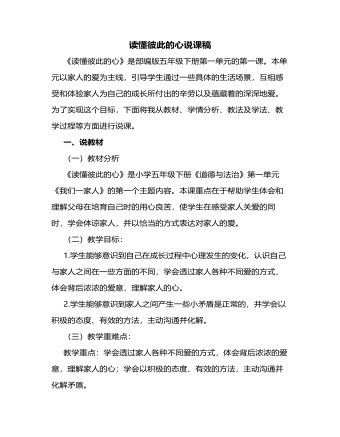
人教部编版道德与法制五年级下册新版读懂彼此的心说课稿
(二)理性面对:交流方式多。1、其实,遇到问题并不可怕,办法总比困难多。2.阅读王玉理的故事,你受到哪些启发?3.交流方式有很多:如写信、留言条等。4.情景出示:班里很多学生都可以用钢笔书写了,由于我写字漏字错字现象多,老师让我再练练,可是妈妈觉得是我写字写得不好。我认为这明明是两个问题,妈妈的误解让我很不开心。如果是你,你会怎么做呢?选择合适的方式,试着主动和妈妈交流沟通吧。(三)我爱家人:发现父母的美。1、小组内合作,阅读课前小调查“我眼中的父母别人眼中的父母”,说说有什么新的发同伴身上学现?2.列举事例说说父母身上的父母的闪光点,交流自己的感受。3.教师总结。(四)拓展延伸:布置活动作业。1.布置课后活动作业。2.小结:明确下节课学习内容。
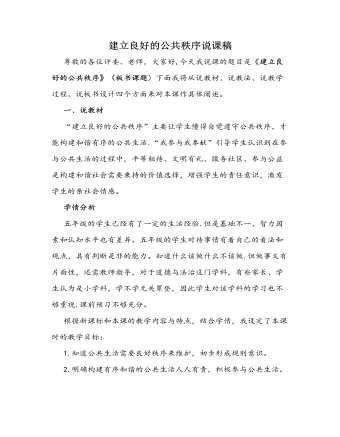
人教部编版道德与法制五年级下册新版建立良好的公共秩序说课稿
教师小结:同学们,通过刚才的讨论,我们明白了只有大家共同遵守规则,才能创造和谐文明的社会环境,正如著名学者莱蒙特所说的:“世界上的一切都必须按照一定的规矩秩序各就各位。”(六)、课堂总结师:通过今天对《建立良好的公共秩序》这一课的学习,我们懂得了什么?在生回答的基础上师进一步谈话:生活中有许多看起来是微不足道的事情,实际上都同社会的主产、生活乃至每个社会成员的工作、学习、生活密不可分,如果一个社会的公共秩序受到了破坏,这个社会的正常生产和生活也就受到极大的影响,社会风气就会颓败,反之如果一个社会的每个成员都学法、懂法、守法、护法,拥有一个良好的公共秩序,那么社会就会有条有理,井然有序,因此建立一个良好的社会公共秩序,是我们大家的迫切希望,希望同学们从我做起,从现在做起,认真遵守公共秩序吧!

人教部编版道德与法制五年级下册新版让我们的家更美好说课稿
小结:生活中家庭可能会发生许多意外变化,需要全家人齐心协力,共渡难关。3.揭示课题:《2让我们的生活更美好》活动一:表达爱1.学生演绎教材活动园内容2.师生讨论:你可以做些什么?3.小结:我们要体谅家庭中的每个成员的辛劳,学会关心他们,支持他们,表达我们对家人的关爱。活动二:争当“智多星”1.生阅读教材阅读角内容2.交流讨论:妈妈为什么愁眉苦脸?她遇到了什么烦心事?我是如何帮助妈妈的?3.小结:生活中,家庭成员有困难,我们要留心观察、主动询问,尽力关心和帮助家人。有困难同商议,共承担。活动三:做好“润滑剂”过渡:日常生活中,家庭成员间很可能会产生纷争。当家人意见不统一时,我们该怎么办呢?1.教材第13页情景(1)看一看:家人之间发生了什么纷争?(2)议一议:你会如何来处理?2.说说生活中你的家庭中有什么困扰争论?
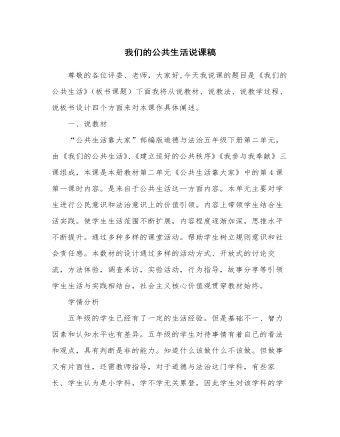
人教部编版道德与法制五年级下册新版我们的公共生活说课稿
活动4:1.在你的周围有哪些常见的公共设施?它们各有什么功能?2.我们能为爱护公共设施做些什么?答案:1.常见公共实施:绿地、道路、路灯、地下(上)线路和管道停车场(库)、配电房(室)及电器设备、消防设备、电梯、健身娱乐设施公告牌等。功能:这些设施为人们提供了宜居的优美环境,为人们日常生活提供了方便,维护了人们正常的生活秩序,使人们的公共生活有了安全保障。2.我们要了解各类公共设施的功能和使用方法,爱惜使用各类公共设施,不损坏公共设施;自觉参与维护公共设施的活动,主动护理公共设施3.爱护公共施的做法有哪些?①要了解各类公共设施的功能和使用方法,爱惜使用各类公共设施,不损坏公共设施;②自觉参与维护公共设施的活动,主动护理公共设施。
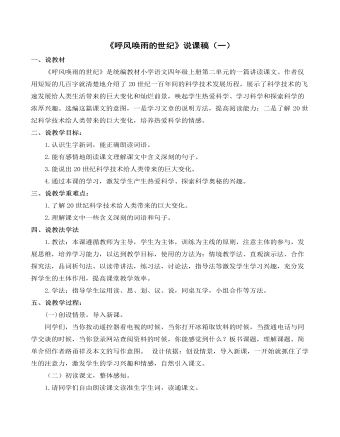
(新)部编人教版四年级上册《呼风唤雨的世纪》说课稿(一)
四、说教法学法 1.教法:本课遵循教师为主导,学生为主体,训练为主线的原则,注意主体的参与,发展思维,培养学习能力,以达到教学目标,使用的方法为:情境教学法、直观演示法、合作探究法,品词析句法、以读带讲法,练习法,讨论法,指导法等激发学生学习兴趣,充分发挥学生的主体作用,提高课堂教学效率。 2.学法:指导学生运用读、思、划、议、说,同桌互学,小组合作等方法。五、说教学过程:(一)创设情景,导入新课。 同学们,当你按动遥控器看电视的时候,当你打开冰箱取饮料的时候,当拨通电话与同学交谈的时候,当你登录网站查阅资料的时候,你能感觉到什么?板书课题,理解课题。简单介绍作者路甬祥及本文的写作意图。 设计依据:创设情景,导入新课,一开始就抓住了学生的注意力,激发学生的学习兴趣和情感,自然引入课文。

